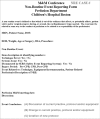The Children's Hospital Boston non-routine event reporting program
- PMID: 20648903
- PMCID: PMC4680042
The Children's Hospital Boston non-routine event reporting program
Abstract
Several authors have described methods to track perfusion and cardiac surgical morbidity and mortality as well as perfusion accidents. There is currently not a standard definition of a perfusion accident nor is there a standard reporting threshold for events which do not directly cause known morbidity. We propose the term non-routine events (NREs) instead of accidents, and provide a working definition and reporting threshold for such. This paper describes the program which we developed to track perfusion NREs within the Cardiovascular Program at Children's Hospital, Boston. NREs are categorized by type (technique, equipment, or patient-related) and bypass period (pre-cardiopulmonary bypass, bypass, or post-cardiopulmonary). NRE outcomes are also classified by the level of discussion or change in perfusion practice after multidisciplinary review. We have documented during a 44 month interval that 42% (29/69) of reported NREs occur during the bypass period and are equipment related and thus, efforts to improve practice should focus there. We have also seen a generally decreasing incidence of NREs requiring either a change in perfusion practice or a new protocol during this time period. We believe that our regular multidisciplinary meetings to discuss NREs have increased awareness among the entire team about potential problems in the program and that intuitively, it has improved patient safety.
Conflict of interest statement
The senior author has stated that authors have reported no material, financial, or other relationship with any healthcare-related business or other entity whose products or services are discussed in this paper.
Figures
References
-
- Kurusz M, Conti VR, Arens JF.. Perfusion accident survey. Proc Am Acad Cardiovasc Perfusion. 1986;7:57–65.
-
- Stoney WS, Alford WC Jr, Burrus GR, Glassford DM Jr, Thomas CS.. Air embolism and other accidents using pump oxygenators. Ann Thorac Surg. 1980;29:336–40. - PubMed
-
- Stammers AH, Mejak BL.. An update on perfusion safety: Does the type of perfusion practice affect the rate of incidents related to cardiopulmonary bypass? Perfusion. 2001;16:189–98. - PubMed
-
- Schabel RK, Berryessa RG, Justison GA, Tyndal CM, Schumann J.. Ten common perfusion problems: Prevention and treatment protocols. J Extra Corpor Technol. 2007;39:203–9. - PubMed
MeSH terms
LinkOut - more resources
Full Text Sources

